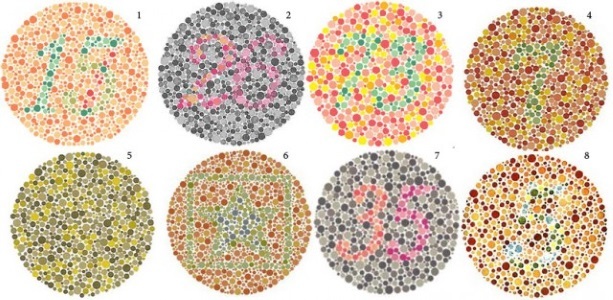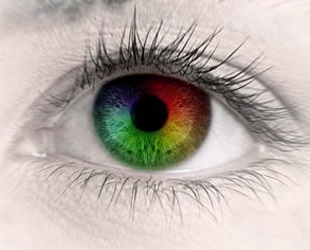
Color blindness is a congenital or acquired violation of the perception of colors.
According to statistics, 10% of the world's population has this peculiarity of sight.
The name of the phenomenon comes from the name of John Dalton, an English chemist and natural scientist, who learned that he does not distinguish between green and red color only on the third decade of life.
- 1. History of the discovery of
- 2. Causes and types of
- 3. Description of forms of color blindness
- 4. Diagnosis and treatment of
- 5. Colors that do not distinguish colorblinds
- 6. Celebrities-colorblind
- 7. Results of
- 8. Video
The history of the discovery of
This happened when, carrying out chemical and biological studies, he realized that he could not distinguish the blue flower from red.
Showing the flower to all of his relatives, he was surprised to find that all members of his family are colorblind, and made a fair conclusion that very often color blindness is inherited.
Later Dalton wrote dozens of valuable scientific works and went down in history as one of the most prominent scientists of his time.
Causes and types of
Because of color blindness, there is no redness of the eyes, itching or stinging in them. Such a deviation in color perception a person may not notice for many years.
In the retina of the human eye there are special nerve cells responsible for the perception of color, which are commonly called cones.

Each cone contains a special pigment. It is the presence of this pigment in the cone that helps a person to distinguish colors.
There are three types of cones: one kind helps to see red, the other green and the third blue.
An ordinary person has all kinds of pigments, but one does not have color blindness. That is why some colors of color blindness are very faded or completely gray.
Traditionally, color blindness is divided into hereditary( congenital) and acquired.
Hereditary form of color blindness is always linked to the X chromosome. Women are usually only carriers of a "broken" gene and do not have symptoms of color disturbance.
But their children( most often male) develop color blindness, in which there is a difficulty in distinguishing between red and green colors.
This is due to the characteristics of the male genome, and men suffer colorblindness 10-30 times more often than women. Nevertheless, in some cases, color blindness can not be called a disease.
More precisely, it will be considered an insignificant feature of vision, because such people can distinguish more shades of other colors that are inaccessible to the average person.
Acquired color blindness occurs as a result of a serious infectious or neurological disease affecting the optic nerves.
Usually, in such people, the disease is constantly progressing, and over time they completely lose the ability to see yellow and blue.
Here are the main conditions leading to the emergence of acquired color blindness:
- age-related degenerative changes( most often cataract and glaucoma), in which not only the perception of colors but also the sight itself worsens;
- administration of certain groups of drugs;
- trauma affecting the optic nerves;
- complicated influenza, meningitis, encephalitis.
Description of the forms of color blindness
Scientists developed a special classification that distinguishes the forms of color blindness in colors that a person can not distinguish.
Achromasia is the absence of color pigments in all the cones of the retina, which leads to a complete inability to see any shades other than gray. Fortunately, this kind of color blindness is diagnosed in very rare cases.
With monochromasia, the patient can see only one color. In addition to violation of color perception, nystagmus and photophobia are often encountered in this case.

People with dichromasia, distinguish 2 colors. Dyschromasia is divided into:
- protanopia( a person does not see the red color);
- deuteranopia( the person does not see the green color);
- tritanopia( a person does not see the blue color and suffers from "night blindness").
Diagnosis and Treatment
Diagnosis
Color blindness is usually diagnosed using simple pigment methods. The most commonly used table is Rabkin, which has been used for over half a century by ophthalmologists around the world.

The table shows a lot of figures composed of circles of different colors, but of equal brightness. Depending on what circles the patient sees, the doctor sets the form and degree of color blindness.
Also used in practice are tables created by other authors. Here are the most common:
- Stalling table;
- table Just;
- table of Ishihara.
Sometimes the "lantern method" and "woolen thread method" are used.
There are also modern hardware methods, which because of their high cost and inaccessibility are used much less often. For the diagnosis of color blindness are used:
- apparatus of Ebnea;
- spectroanomaloscope of Rabkin;
- Nagel spectroanomaloscope.
Treatment of
There are currently no treatments for color blindness with clinically and experimentally proven efficacy.
In some cases, doctors try to restore color perception by wearing lenses, but this method does not yield any meaningful results.

If color blindness is a consequence of the underlying disease, in some cases the color perception is restored after the cause that caused it is eliminated.
One of the promising directions in the therapy of color blindness is genetic engineering. At the moment, scientists conduct experiments, introducing into the cells of laboratory mice the missing genes responsible for the presence of color pigment.
Colors that do not distinguish colorblinds
Depending on the form of the disease, color blindness can not distinguish any color from the color spectrum, but most often( about 80% of cases), patients do not see red.
Celebrities-colorblind
For some outstanding people, color blindness did not become an obstacle in reaching the tops in their favorite case.
| Painter Daltonian |
|
| Color blind directors |
|
| Artists-Daltonians |
|
Results of
- Color blindness is a feature of vision, which is expressed in the inability to see one or more colors.
- Color blindness is congenital and acquired.
- Specific pigment and hardware methods are used to diagnose color blindness.
- There is no reliable treatment that can save a person from color blindness.
Video
The following video is recommended to you:
